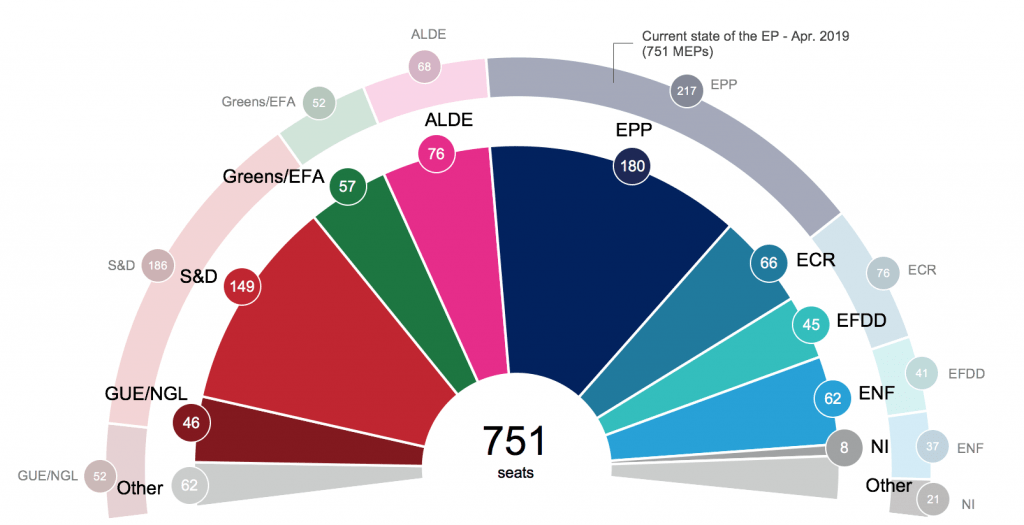On 23 May, Wales will go to the polls to elect four Members of the European Parliament (MEPs). The latest Brexit delay means that the UK will be a member of the EU until 31 October 2019 unless an agreement to leave is agreed before then. On 7 May, the UK Government confirmed that there was not enough time to pass legislation for an agreement before 23 May and so the UK would have to take part. Read last week’s blog for the latest Brexit developments and timeline.
Between 23-26 May, every EU Member State will hold elections in which almost 374 million people are eligible to vote. The European Parliament is the only directly elected EU body and holds elections every five years. The 751 MEPs from across the EU make laws along with the 28 governments of the EU. Seats in the Parliament are arranged in political groups and are allocated based on the population of each Member State. For example, the UK is divided into 12 electoral regions and has 73 seats, of which Wales has four.
UK MEPs elected on 23 May might not take up their seats if an agreement is reached prior to 2 July when the new European Parliament sits for the first time. If this happens, the EU Parliament has confirmed that it will hold an ‘extraordinary session’ to ratify the agreement. This would involve recalling the Parliament in its current composition, meaning that MEPs who have not been re-elected or who have retired would have to return for one last time.
Which voting system is used?
Each Member State elects its MEPs using some form of proportional representation. Most of the UK uses the D’Hondt system (except Northern Ireland, which uses the Single Transferrable Vote system), originating from the 1880s and named after the Belgian mathematician Victor d’Hondt (PDF, 678kb). This system is used to elect European Parliament committee chairs and delegations and is also used for the London Assembly. D’Hondt uses a party list of candidates no greater than the number of seats available (so four for each list in Wales). The distribution of seats using d’Hondt ensures that the proportion of seats is directly proportionate to the proportion of votes won. For example, if a party wins 25% of the vote, it will be allocated around 25% of the available seats. The system is therefore suited to small and medium parties.
Which parties are running?
There are eight parties in the running for four Welsh MEP seats. They are Welsh Labour, the Welsh Conservatives, Plaid Cymru, the Welsh Liberal Democrats, UKIP, the Green Party, the Brexit Party and Change UK. Parties are aligned to their closest European Parliament political group. The two largest groups are the European People’s Party (EPP), comprising of conservative and liberal-conservative parties and the Progressive Alliance of Socialists and Democrats (S&D), comprising centre-left and social-democratic parties. The European Parliament produces a seat projection ahead of the elections. Based on a cross-section of national polls from each Member State, the latest seat projection is:
When will we know the results?
Most EU states will hold their elections on Sunday 26 May. Regardless of when elections take place between 23-26 May, the results from all Member States will become known during the early hours of Monday 27 May. This is to prevent the results from early voting states influencing voters elsewhere. The UK results from the last European Parliament elections in 2014 are available here (including a breakdown for Wales).
Implications for Wales
As well as four MEPs, Wales is represented at other EU institutions and networks, including the European Economic and Social Committee and the Committee of the Regions (read our previous blog here). It also has a strong interest in the working of the European Court of Auditors (in the context of EU funding/finance) and the European Investment Bank (for investment support in Wales). After exit day, the UK will cease membership of EU institutions. During the transition period, Wales will continue to be subject to EU laws but the UK will no longer be part of EU decision making.
The presence of UK MEPs will impact the formation of, and funding allocations for, political groups in the Parliament, including the election of its President. If there are UK MEPs over the summer, this could also influence the selection process for the next European Commission President. Furthermore, the Prime Minister recently spoke of the possibility of extending the Brexit transition period beyond December 2020. If this happens, UK MEPs will sit for much longer than expected.
Coming soon: Our blog on the election results and what they mean for Wales.
Article by Sara Moran, Senedd Research, National Assembly for Wales








